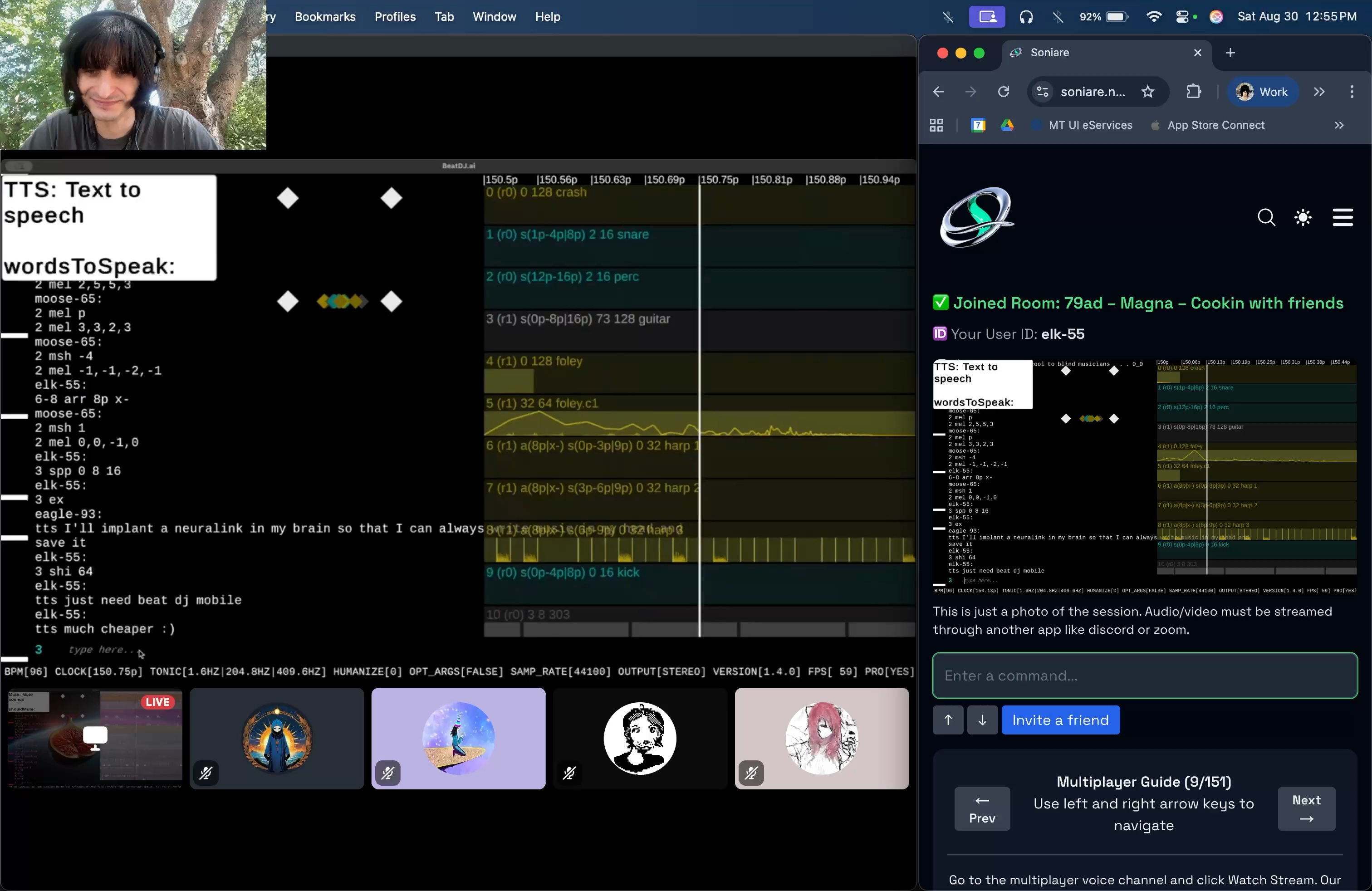- Published on
Collaborative Live Coding: Jamming Remotely with Beat DJ's Multiplayer Mode
- Authors

- Name
- Joshua Jones
Collaborative Live Coding: Jamming Remotely with Beat DJ's Multiplayer Mode
 Collaborative Live Coding Session
Collaborative Live Coding SessionLive coding is often imagined as a solitary practice: one performer at a laptop, lines of code unfolding on a projector, music pulsing as algorithms shape the sound. There's an undeniable beauty in that image, but it can also feel isolating. Many coders want to share the experience with others, to bounce ideas back and forth, to co-create in real time rather than working alone. That's where Soniare's Beat DJ's multiplayer mode changes the story. Instead of coding beats by yourself, you can link up with friends across the world and build music together, line by line, loop by loop, until your session becomes a genuine collaboration.
Breaking Down Barriers to Collaboration
The idea is simple but powerful. Beat DJ allows multiple users to connect into the same live coding session, whether they are sitting side by side in a studio or thousands of miles apart. Once linked, everyone involved can type code that feeds into the shared beat. You might start laying down a rhythm, while your collaborator layers in a bass line, and another adds effects or samples on top. It is still live coding at its core, but suddenly it feels like a band practice conducted through text, with the music forming in sync no matter the distance.
This is especially exciting because collaboration has always been one of the trickiest parts of live coding. Systems like TidalCycles or Strudel focus on powerful pattern manipulation but usually expect a single performer to run the show. If you wanted to jam together, you needed to set up complex technical workarounds, often wrestling with latency, network routing, or mismatched environments. Beat DJ lowers that barrier by making multiplayer a core feature, not an afterthought. You don't need to be a sound engineer or network wizard to join in. You just connect, and you're ready to play.
Beyond Casual Fun: Learning and Performance
The potential here stretches well beyond casual fun. Imagine using multiplayer mode as a learning tool, where a newcomer to live coding joins a session with an experienced coder and sees their techniques unfold in real time. It becomes an interactive classroom, more immediate than watching a tutorial or reading documentation. Or think about how it could fuel remote collaborations between artists who want to co-headline a streaming event without being in the same room. One coder in Bristol, another in Paris, a third in Berlin — suddenly they are all writing beats together, streamed to a global audience.
Even if you're not a performer, the appeal of remote coding jams is obvious. Live coding has a reputation for being experimental, sometimes even intimidating, but collaboration makes it approachable. It's easier to take risks when someone else is there to pick up the thread or counter your ideas with their own. You don't have to carry the weight of an entire set by yourself, and the interplay can spark creative directions you wouldn't have considered alone. Just as bands thrive on the chemistry of different players, Beat DJ sessions thrive on the dialogue between coders.
Embracing the Community Spirit
The collaborative spirit also resonates with the wider culture of algorave and live coding communities. These movements are built on openness, sharing, and experimentation. A tool like Beat DJ, which actively encourages collective creation, fits right into that ethos. It's not just about producing polished tracks; it's about the process of building music together, the thrill of watching code evolve into rhythm and melody before your eyes. Multiplayer mode makes that process accessible and fun, a digital jam session that anyone can join.
Of course, the experience isn't limited to technical experts. Beat DJ's design makes it possible for curious beginners to dive in with friends, even if they've never touched a live coding environment before. Because everything happens in real time, mistakes are part of the performance, and the group can adapt and respond. That flexibility makes it a welcoming space for experimentation, which is exactly what live coding needs to keep growing as both an art form and a community.
Seeing It in Action
Watch Video
If you're curious what this looks like in practice, you can watch collaborative live coding in action in this video. Seeing coders bounce off each other and weave their contributions into a shared piece captures the energy of what Beat DJ's multiplayer mode makes possible. Even though you may not yet have DJ experience or a background in performance, the video shows that it isn't about technical showmanship, it's about connecting with others through code and sound.
An Invitation to Collaborate
Ultimately, the multiplayer mode is an invitation. It's a chance to reimagine live coding not as a solo pursuit but as a collective one, where geography doesn't matter and creativity is amplified by collaboration. Beat DJ offers the tools to make that vision real, and Soniare provides the hub where you can learn, download, and start experimenting yourself. Whether you want to jam with a friend in another city, co-create a set for an online stream, or simply share ideas in real time, Beat DJ gives you the platform to make it happen. Live coding doesn't have to be lonely, with the right tools, it can be a conversation, a dialogue in rhythm and code, a musical journey shared across distance.
